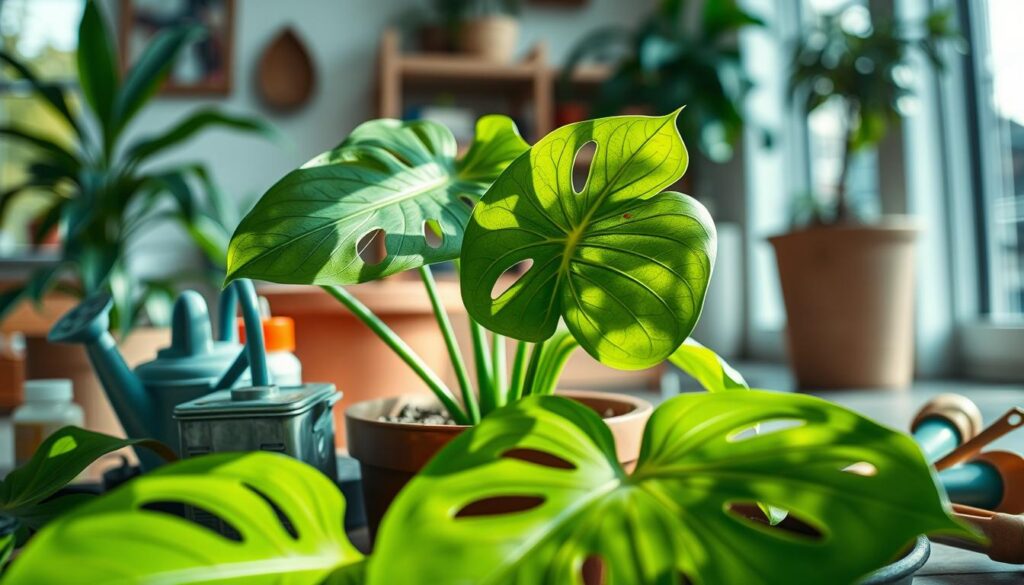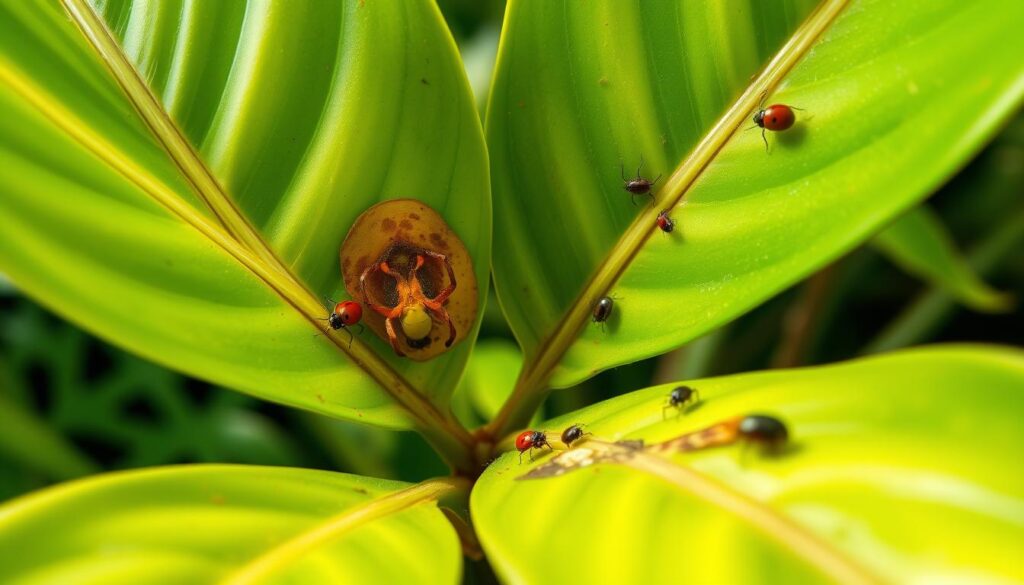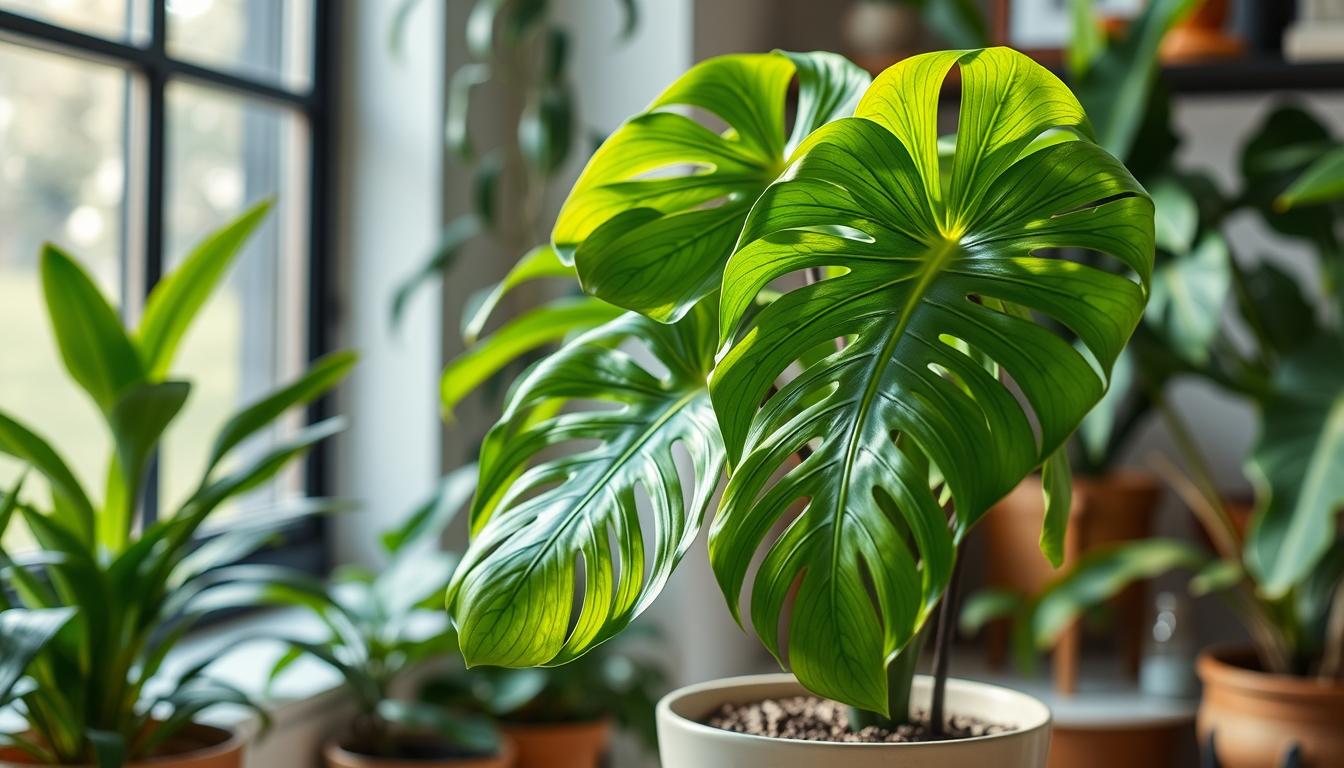Think you don’t have room for houseplants? Think again! Even the tiniest spaces can come to life with the right greenery. These small plants are perfect for small apartments, dorm rooms, or adding a touch of nature to your desk or shelves. With the right care, you can enjoy better air and feel less stressed.
Exploring Mini Monstera plant care reveals its special traits. It can grow well in different lights and needs little care. This makes it a great choice for anyone wanting to bring jungle vibes indoors. By following expert tips, you can keep your plant happy and enjoy its benefits for years.
Key Takeaways
- Mini Monstera plants can improve indoor air quality and reduce stress levels
- Proper Mini Monstera care includes providing optimal light, water, and humidity conditions
- Mini Monstera plant care is relatively low-maintenance, making it perfect for busy individuals
- With proper care, Mini Monstera plants can thrive in small spaces, such as apartments or dorm rooms
- Following expert Mini Monstera care tips can help you enjoy the many benefits of this plant
- Mini Monstera plants are relatively easy to propagate, allowing you to share them with friends and family
Understanding the Mini Monstera: Your New Favorite Houseplant
Thinking about getting a Mini Monstera? It’s good to know its special needs. With the right Mini Monstera care tips, you’ll love this plant. It loves bright, indirect Mini Monstera light requirements to grow well.
Watering your Mini Monstera right is key. Too much water hurts it, and too little makes leaves turn brown. With the right Mini Monstera care tips, your plant will be happy and healthy.
What is a Mini Monstera?
The Mini Monstera, or Rhaphidophora Tetrasperma, grows on trees in the wild. Its split leaves look like they belong in a jungle. This makes it a favorite for indoor plants.
Origin and Natural Habitat
The Mini Monstera comes from Malaysia and Southern Thailand. It loves humid places. You can use a humidifier or group plants to make your home feel like its natural habitat.
Why Choose Mini Monstera?
The Mini Monstera is easy to care for and cleans the air. It’s perfect for adding green to your home. With the right Mini Monstera care tips and Mini Monstera light requirements, you’ll enjoy its beauty.
| Plant Care Aspect | Recommendation |
|---|---|
| Watering | Water about twice a week in summer, and every 7-10 days in winter |
| Lighting | Provide bright, indirect light for 5-8 hours a day |
| Humidity | Maintain a humid environment, ideally between 40-60% |
Essential Care Tips for Your Mini Monstera
To keep your Mini Monstera happy, it needs the right stuff. It loves bright, indirect light. This is perfect for rooms with east- or west-facing windows. For more info, check out trusted houseplant guides.
Watering is key. Keep the Mini Monstera soil moist but not too wet. Wait until the top two inches of soil dry out before watering. This stops root rot and keeps your plant healthy. When you’re Mini Monstera propagation, keep the soil just right.
Here are some important care tips:
- Provide bright, indirect light
- Water consistently, but avoid over-watering
- Maintain moderate humidity levels
- Fertilize regularly during the growing season
Follow these tips and use the right Mini Monstera pruning methods. Your plant will thrive and look amazing. Learn what your plant needs and ask experts if you’re unsure.
With the right care, your Mini Monstera can grow up to 1.5 meters tall. It will be a beautiful part of your home. So, learn about your plant’s needs and enjoy having a healthy Mini Monstera.
Ideal Soil for Mini Monstera Growth
To help your Mini Monstera grow well, pick the right soil. The best soil pH for Mini Monstera is 5.5 to 7.0. Choose a potting mix that drains well and is full of organic stuff. This keeps the soil from getting too wet and stops root rot.
A good mix for Mini Monstera includes peat moss, perlite, and orchid bark. Here’s what a good mix has:
- 25% Coco coir or peat moss for moisture retention
- 25% Perlite or vermiculite for drainage and aeration
- 25% Orchid bark or coco chips for structure and nutrients
- 10% Compost or worm castings for fertility
- 10% Activated charcoal (optional) for toxin removal
Using the right soil and pot helps keep pests away. Also, water your Mini Monstera right. Use low-lime water at room temperature for comfort.
By following these tips, you can make a great home for your Mini Monstera. This helps it grow strong and healthy, without pests.
| Soil Component | Percentage | Benefits |
|---|---|---|
| Coco coir or peat moss | 25% | Moisture retention |
| Perlite or vermiculite | 25% | Drainage and aeration |
| Orchid bark or coco chips | 25% | Structure and nutrients |
| Compost or worm castings | 10% | Fertility |
| Activated charcoal (optional) | 10% | Toxin removal |
Fertilizing Your Mini Monstera
Keeping your Mini Monstera healthy means giving it the right food. Fertilizing is key for its growth. It helps the plant look its best.
Choose a balanced, water-soluble fertilizer for houseplants. It has the nutrients your plant needs. Fertilize every 2 to 4 weeks from spring to fall.
Best Fertilizers for Growth
Look for a fertilizer with a balanced N-P-K ratio. This means your plant gets the right mix for growth. Some fertilizers have more phosphorus for blooming.

When to Fertilize
Fertilize at the right time to avoid harming your plant. Start with a weak solution and adjust as needed. Wait 4 to 6 weeks after repotting before fertilizing again. This way, your Mini Monstera gets the nutrients it needs for growth.
Pruning Your Mini Monstera: A How-To Guide
Pruning is key for Mini Monstera care. It helps control size and encourages new growth. Regular pruning keeps your plant healthy and looking good.
Use clean, sharp tools for pruning. Cut just above a node, where a leaf meets the stem. Don’t prune more than one-third of the plant at once. This avoids stress and helps growth come back fast.
Spring is the best time to prune. It’s when your plant grows the most. After pruning, you can make new plants. This is called Mini Monstera propagation.
Pruning has many benefits:
- It encourages branching and increases leaf density by up to 50%
- It makes your plant look better, possibly increasing its value by about 25%
- It helps air move better and lowers disease risk
Follow these tips to keep your Mini Monstera happy and healthy. Always think about your plant’s health. With care, your Mini Monstera will be a beautiful part of your home.
| Pruning Benefits | Results |
|---|---|
| Encouraging branching | Up to 50% increase in leaf density |
| Enhancing visual appeal | Up to 25% increase in aesthetic value |
| Removing older leaves | Up to 20% increase in healthy foliage growth |
Common Pests and Problems
As a Mini Monstera owner, you might see pests and problems. These can harm your plant. Watch your plant closely and take good care of it. Pests like spider mites and mealybugs can be bad for your plant.
Look for white, cottony patches or small dots on your plant. If you find pests, try insecticidal soap or neem oil. Also, keep your plant in a humid place and don’t overwater it.

Problems like yellow leaves, droopy stems, and slow growth can happen. Fix these by changing how you care for your plant. Give it more light or feed it regularly. Knowing these issues and acting fast can keep your Mini Monstera happy and healthy.
| Pest/Problem | Solution |
|---|---|
| Spider mites | Insecticidal soap or neem oil |
| Mealybugs | Insecticidal soap or neem oil |
| Yellowing leaves | Adjust watering schedule, provide more indirect bright light |
Repotting Your Mini Monstera
As your Mini Monstera grows, it will need a bigger pot soon. This is key for Mini Monstera care and helps with Mini Monstera growth. You’ll need to repot every 1-2 years, or when it’s too big for its pot.
Check if your Mini Monstera needs a new home by looking for roots at the bottom or signs of stress. Pick a pot that’s just a bit bigger. Use a mix that drains well to avoid soggy soil.
- Using a potting mix that consists of 1/2 potting soil and 1/2 coco fiber, with additional materials like coco chips and pumice added for drainage
- Maintaining optimal growing conditions, including temperatures between 65°F and 85°F (20°C and 30°C) and moderate humidity with regular misting
- Watering carefully, with a recommended frequency of every 6 days in hot climates and decreased frequency in winter months
Follow these tips for Mini Monstera care to help your plant grow well. Repot in early spring when it’s most active. Be gentle with the roots to avoid hurting them.
Propagation Techniques for Mini Monstera
There are a few ways to grow Mini Monstera plants. It’s important to pick the right method for you. Growing Mini Monstera can be fun and rewarding. You can share your plants with friends or grow more for yourself.
One way to grow Mini Monstera is by using stem cuttings. Cut a stem section, about 4-6 inches long, from the mother plant. Make sure the cutting has several nodes. This helps the cutting grow roots well.
Stem Cuttings Method
This method is easy and needs little equipment. Cut the stem, remove lower leaves, and put it in water or soil. Keep the soil moist but not too wet. Give it bright, indirect light. Roots will grow in a few weeks, and you can move the plant to a bigger pot.
Water Propagation vs. Soil Propagation
You can also grow Mini Monstera in water. Place the stem cut end in water. This lets you see the roots grow before moving it to soil. Water propagation is good for watching roots and avoiding soil diseases. Knowing how to care for Mini Monstera helps you enjoy growing these plants.
- Choose a healthy stem section with several nodes
- Cut the stem section, removing any lower leaves
- Place the cutting in water or a well-draining soil mix
- Keep the soil consistently moist but not soggy
- Provide bright, indirect light
By following these steps and caring for your Mini Monstera, you can grow more plants. Enjoy the beauty and benefits of these unique plants.
| Propagation Method | Advantages | Disadvantages |
|---|---|---|
| Stem Cuttings | Relatively easy, minimal equipment required | May require more maintenance |
| Water Propagation | Allows for monitoring of root development, reduces risk of soil-borne diseases | May be more time-consuming |
Creating the Perfect Environment
To make your Mini Monstera happy, think about temperature, humidity, and light. It likes temperatures between 65-75°F (18-24°C). This is common in most homes.
Choose a spot that’s not too sunny or drafty. It should have bright, indirect light. For the best Mini Monstera care, keep the temperature right for it to grow.
Some important things to think about are:
- Ideal temperature range: 65-75°F (18-24°C)
- Humidity level: 40-60%
- Light exposure: 5-8 hours of filtered sunlight daily
By following these tips, you can help your Mini Monstera grow well. Make sure the soil isn’t too wet or dry. With the right care, your Mini Monstera will be a beautiful part of your home.
Styling Your Mini Monstera in Home Decor
Styling your Mini Monstera is fun and easy. Its unique vines and leaves bring greenery to any room. Hang it in a basket or on a shelf for a lush look.
For Mini Monstera care tips, choose plants that look good together. Ferns and peace lilies are great choices. They make your Mini Monstera stand out.
- In a hanging basket to add a touch of greenery to a room
- On a shelf to create a lush, jungle-like atmosphere
- Paired with complementary plants, such as ferns and peace lilies
Follow these tips for a stunning display. Your Mini Monstera will look amazing.
Frequently Asked Questions About Mini Monstera Care
Starting to care for a Mini Monstera can raise questions. Let’s tackle some common ones and offer solutions for any problems you might face.
Addressing Pests and Problems
Dealing with pests and problems is a big worry for Mini Monstera owners. These plants are mostly easy to care for but can get spider mites and mealybugs. If pests show up, use insecticidal soap or neem oil to fight them.
Also, keeping the right humidity and not overwatering can stop fungal diseases like root rot.
Troubleshooting Growth and Appearance
Yellow leaves or brown, crispy edges on your Mini Monstera mean it’s stressed. Make sure it gets the right light, water, and humidity. Follow the care tips in this guide to help your plant stay healthy and green.
Being informed and proactive with your Mini Monstera’s care will let you enjoy its beauty for many years. For more tips, check out Trusted Houseplant Guide. They have lots of small, easy plants for city living.





Pingback: The Ultimate Beginner's Guide to the Most Wanted Indoor Plant for 2025 - Trusted House Plant Guide